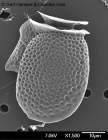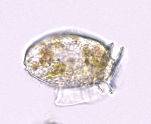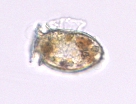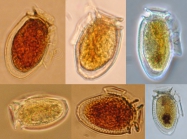
| Intro | | About | | Wiki | | Search traits | | Data explorer | | Literature | | Definitions | | Sources | | Webservices | | Statistics | | Feedback | | Editors | | Log in |
WoRMS taxon detailsDinophysis acuminata Claparède & Lachmann, 1859
109603 (urn:lsid:marinespecies.org:taxname:109603)
accepted
Species
Dinophysis boehmii Paulsen, 1949 · unaccepted (synonym)
Dinophysis borealis Paulsen, 1949 · unaccepted (synonym)
Dinophysis ellipsoides Kofoid, 1907 · unaccepted
Dinophysis lachmanii Solum, 1962 · unaccepted (synonym)
Dinophysis lachmannii Paulsen, 1949 · alternative representation (synonym)
Dinophysis skagii Paulsen, 1949 · unaccepted (synonym)
marine,
Claparède E. & Lachmann J. (1858). Etudes sur les Infusoires et les Rhizopodes. <em>Mém. Inst. Genev.</em> 5, 6: 489 pp. [details]
Type locality contained in Glesnaes
type locality contained in Glesnaes [details]
LSID urn:lsid:algaebase.org:taxname:47067
LSID urn:lsid:algaebase.org:taxname:47067 [details] Description Small to medium species, almost oval or elliptical in shape. Posterior profile is rounded. Left sulcal list well developed,...
Description Small to medium species, almost oval or elliptical in shape. Posterior profile is rounded. Left sulcal list well developed, extends beyond the midpoint of the cell, and is of equal depth. Surface with areolae, each with a pore. [details] Distribution Dinophysis acuminata is widely distributed from cold to warm waters of both hemispheres. Its presence in the Mediterranean...
Distribution Dinophysis acuminata is widely distributed from cold to warm waters of both hemispheres. Its presence in the Mediterranean Sea has not been convincingly demonstrated. [details] Status D. skagii Paulsen has been observed forming couplets with D. acuminata, and is probably a 'small cell' in its life cycle...
Status D. skagii Paulsen has been observed forming couplets with D. acuminata, and is probably a 'small cell' in its life cycle (Reguera & Gonzalez-Gil 2001 and citations therein). [details] Distribution neritic, cold to warm temperate regions, worldwide; often present in late spring to summer.
Distribution neritic, cold to warm temperate regions, worldwide; often present in late spring to summer. [details]
Guiry, M.D. & Guiry, G.M. (2025). AlgaeBase. World-wide electronic publication, National University of Ireland, Galway (taxonomic information republished from AlgaeBase with permission of M.D. Guiry). Dinophysis acuminata Claparède & Lachmann, 1859. Accessed through: World Register of Marine Species at: https://www.marinespecies.org/aphia.php?p=taxdetails&id=109603 on 2025-04-26
Copyright notice: the information originating from AlgaeBase may not be downloaded or replicated by any means, without the written permission of the copyright owner (generally AlgaeBase). Fair usage of data in scientific publications is permitted. Nomenclatureoriginal description
Claparède E. & Lachmann J. (1858). Etudes sur les Infusoires et les Rhizopodes. <em>Mém. Inst. Genev.</em> 5, 6: 489 pp. [details] original description (of Dinophysis ellipsoides Kofoid, 1907) Kofoid, C.A. (1907). Dinoflagellata of the San Diego Region, III. Description of new species. <em>University of California publications. Zoology.</em> 3: 299-304. (look up in IMIS) [details] basis of record Brandt, S. (2001). Dinoflagellates, <B><I>in</I></B>: Costello, M.J. <i>et al.</i> (Ed.) (2001). <i>European register of marine species: a check-list of the marine species in Europe and a bibliography of guides to their identification. Collection Patrimoines Naturels,</i> 50: pp. 47-53 (look up in IMIS) [details] Ecologyecology source
Hansen, P. J.; Tillmann, U. (2020). Mixotrophy in Dinoflagellates: Prey Selection, Physiology and Ecological Importance in Dinoflagellates: Classification, Evolution, Physiology and Ecological Significance. <em>Ed: Subba Rao Durvasula. Publisher: Nova Science Publishers, Inc. New York, USA.</em> [details] ecology source Leles, S. G.; Mitra, A.; Flynn, K. J.; Stoecker, D. K.; Hansen, P. J.; Calbet, A.; McManus, G. B.; Sanders, R. W.; Caron, D. A.; Not, F.; Hallegraeff, G. M.; Pitta, P.; Raven, J. A.; Johnson, M. D.; Glibert, P. M.; Våge, S. (2017). Oceanic protists with different forms of acquired phototrophy display contrasting biogeographies and abundance. <em>Proceedings of the Royal Society B: Biological Sciences.</em> 284(1860): 20170664., available online at https://doi.org/10.1098/rspb.2017.0664 [details] Available for editors ecology source Mitra, A.; Caron, D. A.; Faure, E.; Flynn, K. J.; Leles, S. G.; Hansen, P. J.; McManus, G. B.; Not, F.; Do Rosario Gomes, H.; Santoferrara, L. F.; Stoecker, D. K.; Tillmann, U. (2023). The Mixoplankton Database (MDB): Diversity of photo‐phago‐trophic plankton in form, function, and distribution across the global ocean. <em>Journal of Eukaryotic Microbiology.</em> 70(4)., available online at https://doi.org/10.1111/jeu.12972 [details] ecology source Jacobson, D. M.; Andersen, R. A. (1994). The discovery of mixotrophy in photosynthetic species of Dinophysis (Dinophyceae): light and electron microscopical observations of food vacuoles in Dinophysis acuminata, D. norvegica and two heterotrophic dinophysoid dinoflagellates. <em>Phycologia.</em> 33(2): 97-110., available online at https://doi.org/10.2216/i0031-8884-33-2-97.1 [details] ecology source Park, M.; Kim, S.; Kim, H.; Myung, G.; Kang, Y.; Yih, W. (2006). First successful culture of the marine dinoflagellate Dinophysis acuminata. <em>Aquatic Microbial Ecology.</em> 45: 101-106., available online at https://doi.org/10.3354/ame045101 [details] ecology source Garcia-Cuetos, L.; Moestrup, Ø.; Hansen, P. J.; Daugbjerg, N. (2010). The toxic dinoflagellate Dinophysis acuminata harbors permanent chloroplasts of cryptomonad origin, not kleptochloroplasts. <em>Harmful Algae.</em> 9(1): 25-38., available online at https://doi.org/10.1016/j.hal.2009.07.002 [details] Othercontext source (HKRMS)
Lam CWY. & Ho KC. (1988). Phytoplankton characteristics of Tolo Harbour. In: Morton B, editor. Asian Marine Biology 6. pp 5-18. Hong Kong University Press, Hong Kong. [details]
context source (Schelde) Maris, T., O. Beauchard, S. Van Damme, E. Van den Bergh, S. Wijnhoven & P. Meire. (2013). Referentiematrices en Ecotoopoppervlaktes Annex bij de Evaluatiemethodiek Schelde-estuarium Studie naar “Ecotoopoppervlaktes en intactness index”. [Reference matrices and Ecotope areas Annex to the Evaluation methodology Scheldt estuary Study on “Ecotope areas and intactness index”. <em>Monitor Taskforce Publication Series, 2013-01. NIOZ: Yerseke.</em> 35 pp. (look up in IMIS) [details] additional source Brunel, P., L. Bosse & G. Lamarche. (1998). Catalogue of the marine invertebrates of the estuary and Gulf of St. Lawrence. <em>Canadian Special Publication of Fisheries and Aquatic Sciences, 126.</em> 405 pp. (look up in IMIS) [details] Available for editors additional source Horner, R. A. (2002). A taxonomic guide to some common marine phytoplankton. <em>Biopress Ltd. Bristol.</em> 1-195. [details] additional source Martin, J. L.; LeGresley, M. M. ; Strain, P. M. (2001). Phytoplankton monitoring in the Western Isles region of the Bay of Fundy during 1997-98. <em>Canadian Technical Report of Fisheries and Aquatic Sciences 2349.</em> 4: 1-85. [details] additional source Rosenberg, G. 2004. Malacolog Version 3.3.2: Western Atlantic gastropod database. The Academy of Natural Sciences, Philadelphia, PA., available online at http://www.malacolog.org [details] additional source Gómez, F. (2005). A list of free-living dinoflagellate species in the world's oceans. <em>Acta Bot. Croat.</em> 64(1): 129-212. [details] additional source Guiry, M.D. & Guiry, G.M. (2025). AlgaeBase. <em>World-wide electronic publication, National University of Ireland, Galway.</em> searched on YYYY-MM-DD., available online at http://www.algaebase.org [details] additional source Integrated Taxonomic Information System (ITIS). , available online at http://www.itis.gov [details] additional source Tomas, C.R. (Ed.). (1997). Identifying marine phytoplankton. Academic Press: San Diego, CA [etc.] (USA). ISBN 0-12-693018-X. XV, 858 pp., available online at http://www.sciencedirect.com/science/book/9780126930184 [details] additional source Abé, T.H. (1967). The armoured Dinoflagellata: II. Prorocentridae and Dinophysidae (B) - <i>Dinophysis</i> and its allied genera. <em>Publications of the Seto Marine Biological Laboratory.</em> 2: 37-78. [details] Available for editors additional source Lee J.S., lgarashi T., Fraga S., Dahl E., Hovgaard P. & Yasumoto T. (1989). Determination of diarrhetic shellfish toxins in various dinoflagellate species. <em>J. Appl. Phycol.</em> 1, 147-152. [details] additional source Steidinger, K. A., M. A. Faust, and D. U. Hernández-Becerril. 2009. Dinoflagellates (Dinoflagellata) of the Gulf of Mexico, Pp. 131–154 in Felder, D.L. and D.K. Camp (eds.), Gulf of Mexico–Origins, Waters, and Biota. Biodiversity. Texas A&M Press, College [details] additional source Moestrup, Ø., Akselman, R., Cronberg, G., Elbraechter, M., Fraga, S., Halim, Y., Hansen, G., Hoppenrath, M., Larsen, J., Lundholm, N., Nguyen, L. N., Zingone, A. (Eds) (2009 onwards). IOC-UNESCO Taxonomic Reference List of Harmful Micro Algae., available online at http://www.marinespecies.org/HAB [details] additional source Liu, J.Y. [Ruiyu] (ed.). (2008). Checklist of marine biota of China seas. <em>China Science Press.</em> 1267 pp. (look up in IMIS) [details] Available for editors additional source Lakkis, S. (2011). Le phytoplancton marin du Liban (Méditerranée orientale): biologie, biodiversité, biogéographie. Aracne: Roma. ISBN 978-88-548-4243-4. 293 pp. (look up in IMIS) [details] additional source Chang, F.H.; Charleston, W.A.G.; McKenna, P.B.; Clowes, C.D.; Wilson, G.J.; Broady, P.A. (2012). Phylum Myzozoa: dinoflagellates, perkinsids, ellobiopsids, sporozoans, in: Gordon, D.P. (Ed.) (2012). New Zealand inventory of biodiversity: 3. Kingdoms Bacteria, Protozoa, Chromista, Plantae, Fungi. pp. 175-216. [details] additional source Steidinger, K.A.; Tangen, K. (1997). Dinoflagellates. pp. 387-584. In: C.R. Tomas (ed.) (1997). Identifying Marine Phytoplankton. Academic Press: San Diego, CA [etc.] (USA). ISBN 0-12-693018-X. XV, 858 pp., available online at http://www.sciencedirect.com/science/article/pii/B9780126930184500057 [details] additional source Balech, E. (2002). Dinoflagelados tecados tóxicos en el Cono Sur Americano. <em>In: Sar, E.A., Ferrario, M.E. & Reguera, B. (Eds.). Floraciones Algales Nocivas en el Cono Sur Americano. Instituto Español de Oceanografía.</em> pp. 123-144. [details] Available for editors  Present Present  Present in aphia/obis/gbif/idigbio Present in aphia/obis/gbif/idigbio  Inaccurate Inaccurate  Introduced: alien Introduced: alien  Containing type locality Containing type locality
From editor or global species database
LSID urn:lsid:algaebase.org:taxname:47067 [details]From regional or thematic species database
Description Small to medium species, almost oval or elliptical in shape. Posterior profile is rounded. Left sulcal list well developed, extends beyond the midpoint of the cell, and is of equal depth. Surface with areolae, each with a pore. [details]Distribution Dinophysis acuminata is widely distributed from cold to warm waters of both hemispheres. Its presence in the Mediterranean Sea has not been convincingly demonstrated. [details] Harmful effect The main agent of DSP outbreaks in European Atlantic coasts. Also associated with DSP outbreaks in NE Japan and New Zealand. In recent years, first report of DSP outbreaks associated with blooms of this species in NW (Esenkulova & Haigh 2012) and NE North America (Hattenrath-Lehmann et al. 2012). Producer of okadaic acid (OA), dinophysis toxins (DTXs)—toxins implicated in DSP outbreaks—and pectenotoxins (PTXs). Some strains appear to produce only PTX (Nielsen et al. 2012), others only OA (Fernández et al. 2001), others DTX1 and PTX2 (Suzuki et al. 2009) or a mixture of OA, DTXs and PTXs (Miles et al. 2004). 1. Strains producing only pectenotoxins: Denmark: Nielsen et al. 2012. 2. Strains producing only okadaic acid: Spain: Fernández et al. 2001. 3. Strains producing DTX1 and PTX2 NE Japan: Suzuki et al. 2009 4. A mixture of OA, DTXs and PTXs Norway: Miles et al. 2004 NE USA: Hackett et al. 2009 D. acuminata and D. acuta are the main DSP toxin producers in Europe (Reguera et al. 2012) [details] Identification Dinophysis acuminata is smaller than D. acuta and the most antapical rib of the sulcal wing is not directed antapically. Dinophysis norvegica has a different shape of the hyposome. [details] Introduced species impact Chinese part of the Yellow Sea (Marine Region) Other impact - undefined or uncertain (Bloom forming) [details] Introduced species vector dispersal Chinese part of the Yellow Sea (Marine Region) Ships: General [details] Introduced species vector dispersal Chilean part of the South Atlantic Ocean (Marine Region) Ships: accidental with ballast water, sea water systems, live wells or other deck basins [details] Status D. skagii Paulsen has been observed forming couplets with D. acuminata, and is probably a 'small cell' in its life cycle (Reguera & Gonzalez-Gil 2001 and citations therein). [details] Unreviewed
Diet general for group: both heterotrophic (eat other organisms) and autotrophic (photosynthetic) [details]Distribution neritic, cold to warm temperate regions, worldwide; often present in late spring to summer. [details] Habitat pelagic [details] Importance General: known for producing dangerous toxins, particularly when in large numbers, called "red tides" because the cells are so abundant they make water change color. Also they can produce non-fatal or fatal amounts of toxins in predators (particularly shellfish) that may be eaten by humans. [details] Predators marine microorganisms and animal larvae [details] Reproduction general for group: both sexual and asexual [details] Spelling written D. acuminata by Louis et al. (1974) [details]
Published in AlgaeBase
 Published in AlgaeBase  (from synonym Dinophysis skagii Paulsen, 1949) (from synonym Dinophysis skagii Paulsen, 1949)Published in AlgaeBase  (from synonym Dinophysis boehmii Paulsen, 1949) (from synonym Dinophysis boehmii Paulsen, 1949)Published in AlgaeBase  (from synonym Dinophysis borealis Paulsen, 1949) (from synonym Dinophysis borealis Paulsen, 1949)Published in AlgaeBase  (from synonym Dinophysis ellipsoides Kofoid, 1907) (from synonym Dinophysis ellipsoides Kofoid, 1907)Published in AlgaeBase  (from synonym Dinophysis lachmannii Paulsen, 1949) (from synonym Dinophysis lachmannii Paulsen, 1949)Published in AlgaeBase  (from synonym Dinophysis lachmanii Solum, 1962) (from synonym Dinophysis lachmanii Solum, 1962)To Barcode of Life (6 barcodes) To Biodiversity Heritage Library (1 publication) (from synonym Dinophysis lachmannii Paulsen, 1949) To Biodiversity Heritage Library (1 publication) (from synonym Dinophysis borealis Paulsen, 1949) To Biodiversity Heritage Library (52 publications) To Biodiversity Heritage Library (6 publications) (from synonym Dinophysis ellipsoides Kofoid, 1907) To Dyntaxa To Dyntaxa (from synonym Dinophysis skagii Paulsen, 1949) To European Nucleotide Archive, ENA (Dinophysis acuminata) To GenBank (2 nucleotides; 1 proteins) (from synonym Dinophysis skagii Paulsen, 1949) To GenBank (74592 nucleotides; 27061 proteins) To PESI (from synonym Dinophysis skagii Paulsen, 1949) To PESI To ITIS |




